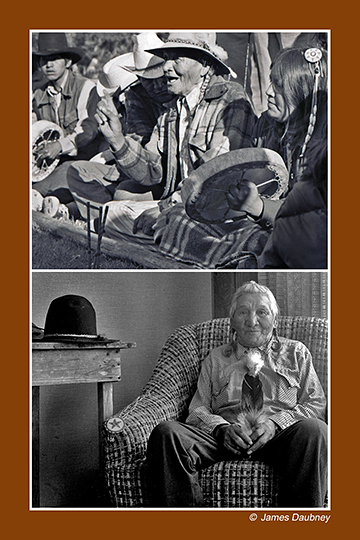Hanson Bearspaw was like a grandfather to photographer
COFFEE WITH WARREN, with Warren Harbeck
Cochrane Eagle, March 20, 2014

Fun-loving Stoney Nakoda elder Hanson Bearspaw (died 1982) is pictured here, top, participating in hand game at Banff Indian Days, 1975; bottom, relaxing at home in Morley, 1981. Photos by James Daubney
Members of his Stoney Nakoda First Nation at Morley knew him as a community leader and a very humourous storyteller. Unlucky bull riders knew him as a rodeo clown who protected them from angry hooves and horns.
Cochrane photographer James Daubney knew Hanson Bearspaw as a grandfather figure and a treasured link to an era barely one generation removed from herds of buffalo and the signing of Treaty Seven.
Jim has distinguished himself over the years as a heritage photographer. His prints, mostly black and white, can be found in the collections of the National Gallery of Canada in Ottawa, the Peter Whyte Foundation in Banff, and elsewhere.
His images usually depict scenes from nature, but occasionally celebrate people, too. (See my July 27, 2011 column featuring Jim’s photo of the famous American composer John Cage. Like Cage, Jim also thinks a lot about intentional listening, but expressed through a different art form.)
Over the years, Jim has made many friends with his lens, but Hanson was special. At Coffee Traders the other day, Jim shared with me some of his memories and photos of the iconic Stoney elder who was born in the 1890s and died in 1982.
They first met at Banff Indian Days in the mid-1970s, Jim says.
Banff Indians Days was a summer encampment of First Nations folks, mostly from Morley, in which visitors to Banff National Park could meet and interact with representatives of traditional aboriginal culture. Begun about the time of Hanson’s birth, it was held near the Banff townsite through 1978, put on hold for a few years, and recently revived.
Traditional hand games were often played during Banff Indian Days. Hand games are played by two teams, one a hiding team, and the other a guessing team. Accompanied by hand-drumming, the guessing team tries to guess the arrangement of specially marked bones concealed in the hands of the hiding team.
Jim came across Hanson engaged in a hand game at sundown and took the top photo accompanying this column.
(Photography buffs will be interested to know that, in taking that photo, Jim used one of those classic Rolleiflex f/2.8 twin lens reflex cameras that used 120 roll film that he actually had to develop by hand – back in the dark ages before the arrival of digital technology!)
It was at Hanson’s home in Morley some years later where Jim took the bottom photo of Hanson sitting in his favourite chair, his trademark hat on the nearby table, eagle feather and beaded accessories at hand.
Jim and another friend, Hanson’s cousin Tom Kaquitts (of Sulfur Mountain tourism fame), were enjoying an afternoon visit with Hanson. They chatted about many things, including Hanson’s well-informed interest in political issues.
At the end of their visit Hanson gave Jim a pouch of kinnikinnick as a token of their friendship, a memento never to be forgotten.
“Hanson’s generation was pretty special,” Jim says. “They were born into what was still a very traditional culture. Their fathers had seen the buffalo roaming freely. Hanson’s father had been part of the Treaty Seven negotiations.”
Jim reminisces that his own beloved paternal grandfather had passed away some years earlier. “Now this was like having two grandfathers, Hanson and Tom,” Jim says.
Yes, Jim, from my own experience with a number of Stoney elders I can relate to your experience of Hanson’s grandfatherliness. What a privilege! Thanks so much for sharing your memories of this outstanding gentleman.
© 2014 Warren Harbeck
JoinMe@coffeewithwarren.com